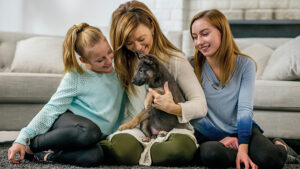In fact, it takes the average pet owner almost four months to get into the flow with a new four-legged family member, according to a survey by Royal Canin. Eight in 10 respondents said the first year of pet ownership is the most important, but that doesn’t mean it’s easy. The survey found 64 percent believe the first year is also the most difficult and deciding how to train a new pet was cited as the most important decision pet parents have to make.
“Bringing a puppy home is a hugely rewarding experience for pet owners, but it’s also a time of huge challenges and steep learning curves,” says Dr. Jill Cline, pet nutritionist and site director of Royal Canin’s Pet Health and Nutrition Center. “In addition to helping your puppy adjust to its new home, you can support your puppy’s health now and always with a nutritionally complete diet tailored to its specific needs.”
Make welcoming a new puppy a rewarding experience for the whole family with these tips.
Arriving Home
Your puppy may be feeling stressed by new sights, sounds, smells, and the separation from its mother. Manage the noise and activity to avoid adding to this stress.
As soon as you get home, take your puppy to your yard or outside area so it can go to the bathroom. Use positive verbal reinforcement when the job is done.
Once indoors, block off a safe area and let your puppy sniff and explore on its own time. Getting acquainted with a new place takes time and lots of exploring. Some puppies can be overwhelmed by too much human contact, so allow your puppy to come to you.
Getting Settled
Puppies like to know what to expect. Plan your routine for feeding, potty trips, exercise and grooming so you can get started on day one. If you know what routine your puppy had before adoption, it’s best to continue for consistency until your puppy is settled.
Any sudden dietary changes can cause stress or digestive problems, so for the first week or two, give your puppy the same food as its previous owner, following the feeding recommendations on the package. Nutrition tailored to specific developmental needs can help fragile, young puppies grow into strong, healthy dogs. It’s important to select high-quality food based on age and expected adult size.
Your puppy’s eating spot should be away from where you and any other pets eat. Allow your puppy to eat in peace to prevent it from feeling nervous or protective.





